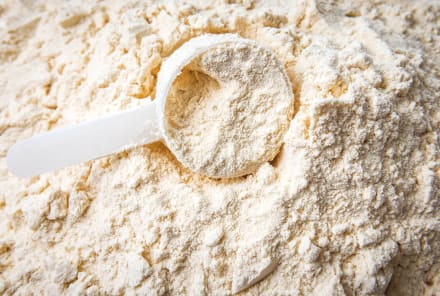Advertisement
What Everyone Gets Wrong About Inflammation


Sometimes we oversimplify concepts in health and nutrition. We classify hormones like cortisol, insulin, or testosterone as good or bad when they actually behave in a far more complex and intricate way within the body.
So, too, with inflammation. In the short term, it can save your life. Let's say you get a nasty paper cut at work. Immediately, your immune cells step in to protect against pathogens and heal the wound.
We call that acute inflammation: Your white blood cells steps in, do their job, and then leave.
In the short term, inflammation can save your life.
But there's another type of inflammation that sticks around way after the party ends. Chronic inflammation is like that dinner guest who can't take the hint to leave. Whereas he was quiet in the beginning, as he becomes more inebriated, the louder he becomes.
Chronic inflammatory diseases can take years before you see their first signs, but their destruction is far-reaching. Inflammation in these cases is working at the microscopic level—you won't see it with your eyes until it is bad enough to cause something like a swollen joint. And it isn't an isolated problem: Chronic inflammation goes hand-in-hand with other issues like oxidative damage1 that when taken together trigger or exacerbate disease and make you age more rapidly.
Numerous things may fuel that inflammatory fire, including toxins in the environment you are exposed to on a daily basis. Consider that about 80,000 chemicals are registered in America, and every year about 2,000 new ones appear. Most haven't been tested for long-term safety in humans.
So, too, can prescription drugs, antibiotics, chronic stress, lack of sleep, and especially what you eat.
Our heavily processed, sugary, gut-damaging, inflammatory diet paves the way for obesity but also type 2 diabetes and all its complications, fueling that low-grade inflammation2.
As a medical doctor who specializes in functional medicine and gut health, I see how chronic inflammation is directly related to gut disorders, like dysbiosis, small intestinal bacterial overgrowth and leaky gut syndrome.
What affects your gut also affects your brain. Consider that your gut makes about 95 percent of your feel-good neurotransmitter serotonin. That could explain why inflammation often leads to mood disorders. For example, researchers have found a link between chronic stress, inflammation, and depression3.
Chronic inflammation is sometimes called the silent killer: It plays a role in nearly every disease4. Inflammation at its worst is deadly, like a massive heart attack or stroke; yet, for many chronic inflammatory conditions it can take years before their symptoms become apparent, by which time a lot of the damage has already occurred.
How do you measure inflammation?
We are all inflamed to some degree (for a few strategies on how to tame inflammation, check out this article and this one). Signs and symptoms of chronic inflammation are sometimes obvious, such as fatigue and pain. Other times, they aren't so obvious and can simmer for years before they manifest as symptoms.
I can usually determine chronic inflammation among patients with specific findings on their physical exam:
- Obesity (a BMI > 30.0; BMI = [Weight (lbs.)/height (in.)2] x 703), which can ramp up inflammation but also make you more prone to problems like blood clots.
- High blood pressure (>130/85)
- Increased waist circumference (Men >40 in.; women > 35 in.)
- Dark circles around the eyes
- Skin rashes (hives, eczema, psoriasis)
- Tenderness or fluid around joints
I also look at my patients' blood work, which can reveal hidden chronic inflammation. Inflammatory markers, such as C-reactive protein (CRP)5, are able to predict problems including future cardiovascular issues, like a heart attack (even in women).
C-reactive protein (CRP) is a protein your liver makes. Elevated levels indicate your body is harboring inflammation somewhere. Your doctor is able to measure levels with a high-sensitivity C-reactive protein test, sometimes also called an hs-CRP test. If it's greater than 3.0 mg/L, it is elevated and will put you at increased disease risk.
Other inflammatory markers I frequently use in my practice include:
- Lp-PLA2
- Ferritin
- CBC (complete blood count)
- Liver function tests, including GGT (gamma-glutamyl transferase)
- Fasting blood sugar (ideally < 90)
- HGBa1c (ideally < 5.7)
- Low HDL (good cholesterol) [<50 mg/dl women; <40 mg/dl men]
Ask your doctor to measure these levels. He or she should then review and discuss the results with you, including helping you find optimal levels and strategies to normalize these inflammatory markers.
When I measure inflammation in my patients, I also look at two key fatty acids. One is the omega-6 fatty acid arachidonic acid (AA), which is the precursor to pro-inflammatory signaling molecules known as eicosanoids. The other fatty acid is the omega-3 fatty acid eicosapentaenoic acid (EPA), which generates anti-inflammatory eicosanoids.
Once upon a time, we consumed about equal amounts of omega-6 and omega-3 fatty acids. Today, research shows we eat 20 or more times6 omega-6s than omega-3s, which fuels the inflammatory fires that keep us fat, sick, and achy.
The higher the AA/EPA ratio in the blood, the greater the level7 of silent inflammation that is likely to be found throughout your organs and blood vessels. And that's where your diet comes in.
Fight inflammation with your fork.
Chronic inflammation has many culprits, and foremost among them is what you eat. That's actually good news because you have the power to dial down inflammation starting with your very next meal.
Food is information, and when my patients lose weight, they reduce inflammation, which in turn helps them lose more weight. Foremost among those strategies is to reduce the amount of inflammatory foods and increase anti-inflammatory ones.
Inflammatory foods aren't always obvious. Sometimes they get cloaked as healthy, or they might be healthy foods with unhealthy ingredients. Watch out for "-friendly" labels, as the food industry is quite savvy in making unhealthy products look healthy and appealing. Among them are included:
- Vegetable oils and other oils high in inflammatory omega-6 fatty acids
- Grain-fed meats and farm-raised fish
- Damaged and hydrogenated fats
- Trans fats
- Food sensitivities, including the two biggest ones—gluten and dairy
- Sugar in all its many disguises (including refined carbs)
- Raw nuts and seeds
- Soy
- Genetically modified crops
- Most processed, boxed foods in the grocery store's center aisles
- Gluten-free cookies, crackers, and other "healthy" junk foods
An anti-inflammatory diet, on the other hand, includes plenty of foods rich in omega-3 fatty acids, including wild-caught fish, walnuts, avocado, and freshly ground flax and chia seeds. These foods taper down inflammation while supporting a healthy gut with their dietary fibers.
Other great sources of healthy anti-inflammatory fats include extra-virgin coconut and olive oils, grass-fed beef, and sprouted nuts and seeds. You'll also want to incorporate plenty of colorful nonstarchy plant foods and sufficient but not excessive protein.
An ideal way to incorporate this plan is with a ketogenic diet. Inflammatory foods like dairy and grain-fed meats may slip into a ketogenic plan, so you'll want to be very careful about focusing on anti-inflammatory ones to get the diet's full benefits, remembering to eat mostly plants and spices for the inflammation-fighting properties.
Intermittent fasting offers a great way to complement the anti-inflammatory power of a ketogenic diet. When you give the digestive system a break, you reduce inflammation in your gut, which reduces inflammation throughout your entire body. This article can help you determine the best fasting plan. Take it a step further, and a five-day fasting-mimicking diet will turn on longevity genes that rejuvenate your cells while helping your body dump old cellular debris.
Working with your doctor can reveal where microscopic inflammation is coming from, but at the end of the day, it comes down to food and lifestyle. It's what you eat that can make the most dramatic difference in reducing body-wide inflammation.

Vincent M. Pedre, M.D., medical director of Pedre Integrative Health and president of Dr. Pedre Wellness, is a board-certified internist in private practice in New York City since 2004. He completed his bachelor’s degree in Biology at Cornell University before attending the University of Miami School of Medicine and completed his residency in Internal Medicine at the Mount Sinai School of Medicine. He has appeared on the Martha Stewart Show and ABC and is the author of Happy Gut: The Cleansing Program to Help You Lose Weight, Gain Energy, and Eliminate Pain. Dr. Pedre is a clinical instructor in medicine at the Mount Sinai School of Medicine and is certified in yoga and medical acupuncture.
More from the author:
Functional Nutrition Training
Check out Functional Nutrition Coaching
A cutting-edge nutrition deep dive taught by 20+ top health & wellness experts
Learn moreMore from the author:
Functional Nutrition Training
Check out Functional Nutrition Coaching
A cutting-edge nutrition deep dive taught by 20+ top health & wellness experts
Learn more
Vincent M. Pedre, M.D., medical director of Pedre Integrative Health and president of Dr. Pedre Wellness, is a board-certified internist in private practice in New York City since 2004. He completed his bachelor’s degree in Biology at Cornell University before attending the University of Miami School of Medicine and completed his residency in Internal Medicine at the Mount Sinai School of Medicine. He has appeared on the Martha Stewart Show and ABC and is the author of Happy Gut: The Cleansing Program to Help You Lose Weight, Gain Energy, and Eliminate Pain. Dr. Pedre is a clinical instructor in medicine at the Mount Sinai School of Medicine and is certified in yoga and medical acupuncture.
7 Sources
- https://www.ncbi.nlm.nih.gov/pubmed/23607184
- https://www.ncbi.nlm.nih.gov/pubmed/15673055
- https://www.ncbi.nlm.nih.gov/pmc/articles/PMC4006295/
- https://www.ncbi.nlm.nih.gov/pmc/articles/PMC3492709/
- https://www.ncbi.nlm.nih.gov/pubmed/15823493
- https://www.ncbi.nlm.nih.gov/pmc/articles/PMC4808858/
- https://www.ncbi.nlm.nih.gov/pmc/articles/PMC2952901/
Watch Next
Enjoy some of our favorite clips from classes
Enjoy some of our favorite clips from classes
What Is Meditation?
Mindfulness/Spirituality | Light Watkins
Box Breathing
Mindfulness/Spirituality | Gwen Dittmar
What Breathwork Can Address
Mindfulness/Spirituality | Gwen Dittmar
The 8 Limbs of Yoga - What is Asana?
Yoga | Caley Alyssa
Two Standing Postures to Open Up Tight Hips
Yoga | Caley Alyssa
How Plants Can Optimize Athletic Performance
Nutrition | Rich Roll
What to Eat Before a Workout
Nutrition | Rich Roll
How Ayurveda Helps Us Navigate Modern Life
Nutrition | Sahara Rose
Messages About Love & Relationships
Love & Relationships | Esther Perel
Love Languages
Love & Relationships | Esther Perel

















